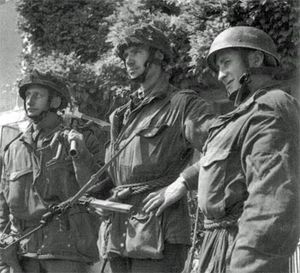
Back الفرقة البريطانية السادسة المحمولة جوا Arabic 6a Divisió Aerotransportada (Regne Unit) Catalan 6th Airborne Division German 6.ª División Aerotransportada (Reino Unido) Spanish لشکر ۶ هوابرد (بریتانیا) Persian Brittiläinen 6. laskuvarjodivisioona Finnish 6e division aéroportée (Royaume-Uni) French הדיוויזיה המוטסת השישית (בריטניה) HE 6th Airborne Division Italian 제6공수사단 Korean
| 6th British Airborne Division | |
|---|---|
 Glider infantry of D Company, 2nd Battalion, Oxfordshire and Buckinghamshire Light Infantry, of the 6th Airlanding Brigade, 6th Airborne Division, in Normandy 1944. | |
| Active | 1943–1948 |
| Country | |
| Branch | |
| Type | Paratrooper |
| Role | Airborne forces Raiding Reconnaissance |
| Size | Division |
| Nickname(s) | Red Devils [nb 1] |
| Motto(s) | Go To It[2] |
| Engagements | World War II Capture of the Caen canal and Orne river bridges Operation Tonga Battle of Merville Gun Battery Operation Mallard Battle of Bréville Advance to the River Seine Battle of the Bulge Operation Varsity Palestine Emergency |
| Commanders | |
| Notable commanders | Sir Richard Gale Sir James Cassels Sir Hugh Stockwell |
| Insignia | |
| Emblem of the British airborne forces |  |
The 6th Airborne Division was an airborne infantry division of the British Army during the Second World War. Despite its name, the 6th was actually the second of two airborne divisions raised by the British Army during the war, the other being the 1st Airborne Division.[3] The 6th Airborne Division was formed in the Second World War, in mid-1943, and was commanded by Major-General Richard N. Gale. The division consisted of the 3rd and 5th Parachute Brigades along with the 6th Airlanding Brigade and supporting units.
The division's initial operation, which also resulted in it becoming the first Allied unit to land its troops in France as part of Operation Overlord, was Operation Tonga on 6 June 1944, D-Day, part of the Normandy landings, where it was responsible for securing the left flank of the Allied invasion. Having successfully carried out this task the division remained in Normandy for three months before being withdrawn in September. The division was entrained day after day later that month, over nearly a week, preparing to join Operation Market Garden but was eventually stood down. While still recruiting and reforming in England, it was mobilised again and sent to Belgium in December 1944, to help counter the surprise German offensive in the Ardennes, the Battle of the Bulge. Their final airborne mission followed in March 1945, Operation Varsity, the second Allied airborne assault over the River Rhine.
After the war the division was identified as the Imperial Strategic Reserve, and moved to the Middle East. Initially sent to Palestine for parachute training, the division became involved in an internal security role. In Palestine, the division went through several changes in formation, and had been reduced in size to only two parachute brigades by the time it was disbanded in 1948.
- ^ Otway, p.88
- ^ Saunders, p.189
- ^ "The 6th Airborne Division in Normandy". www.pegasusarchive.org. Retrieved 22 February 2016.
Cite error: There are <ref group=nb> tags on this page, but the references will not show without a {{reflist|group=nb}} template (see the help page).
© MMXXIII Rich X Search. We shall prevail. All rights reserved. Rich X Search